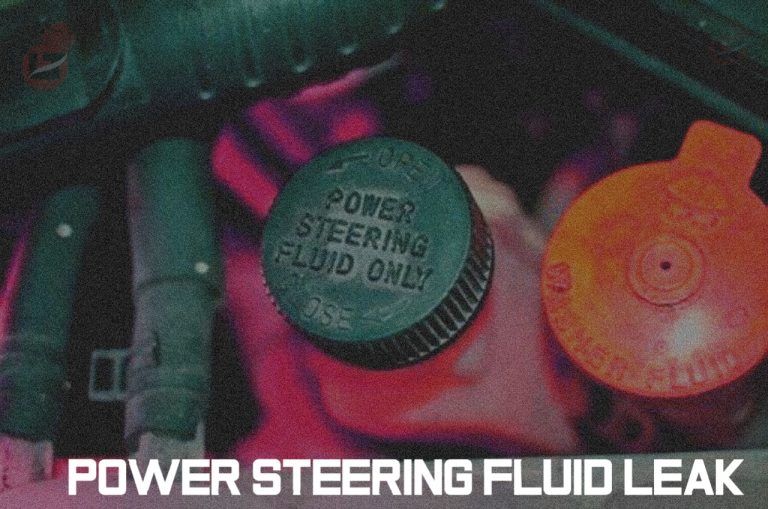The proper functioning of several components is crucial for cars to run smoothly. Fluids power most of these components to ensure optimal performance on the road.
The power steering fluid, for instance, aids in the seamless turning of the steering wheel; if there’s a leak in the system that causes the fluid to go dry, the driver’s ability to steer the steering wheel will be impacted, posing a severe risk.
Continue reading as we show you all you need about power steering fluid leaks.
Symptoms Of Power Steering Fluid Leak
Identifying power steering fluid leak symptoms doesn’t require professional skills or knowledge. Several signs indicate a problem with a vehicle’s power steering fluid. Here are some common symptoms of power steering fluid leaks that are noticeable in some cars:
1. Fluid on the garage floor
If your car’s steering system is faulty due to a fluid leak, you may notice fluid on the garage floor under the engine area, particularly when you start the car in the morning. To confirm if the leak is from the power steering fluid, you should check around the garage for oil stains on the floor, particularly when the car is turned off. This could indicate that the steering system is leaking fluid.
2. Ignition noise
If your vehicle’s power steering fluid leaks, it can impact ignition. A common symptom is a squealing noise from the steering pump when you turn the ignition ON. This may be followed by the dashboard warning light being triggered. If you notice these signs, your power steering fluid may be leaking.
3. Grinding or whining noise
Vehicles typically have quiet steering systems that operate smoothly without making noise when turning. However, a malfunction, such as a fluid leak, can cause noise in the steering system.
Over time, if the steering system leaks fluid, the fluid level will decrease, resulting in a whining or grinding sound when turning left or right. It is essential to promptly address any power steering fluid leaks to avoid further damage to the steering system.
4. Delayed steering wheel response
If you experience a delay in steering wheel response while driving, it could be due to a power steering fluid leak. This common symptom can cause frustration and even danger when making turns or maneuvering in traffic. The leaking power steering pump can cause a delay in the steering wheel response.
Addressing this issue by consulting with a mechanic as soon as possible is essential. Ignoring the problem can lead to more serious issues and potential dangers on the road. The mechanic will be able to diagnose and fix the issue, ensuring that your vehicle’s steering system is functioning correctly and safely.
How To Fix Leaking Power Steering Fluid
When symptoms of a leaking power steering fluid are noticed, it is crucial to fix it immediately to prevent further damage. While some issues can be solved with a simple adjustment to the steering system, neglect can escalate the problem.
If the steering fluid leak persists even after adjusting the steering system, it is necessary to seek the help of a mechanic. However, if you have some mechanical skills and experience, fixing the problem yourself is possible.
You need to follow a procedure to fix a power steering fluid leak.
1. Flush/clean the power steering
Before attempting to fix a power steering fluid leak, it’s essential to flush or clean the power steering system to remove any dirt or debris that may be causing the issue.
By flushing or cleaning the power steering system, you can eliminate any blockages or obstructions that may be hindering the smooth operation of the steering system.
This process can take anywhere from a few minutes to several hours, depending on the severity of the issue and the type of cleaning method used.
2. Replace worn-out parts
To prevent further damage to your steering system, it’s essential to replace any worn-out parts immediately. If you notice any loose nuts or worn-out hoses, the best approach is to tighten the loose nuts and replace any defective parts.
Replacing old hoses with new ones is advisable since they may no longer be in good shape. Additionally, check for defective caps that prevent fluid from spilling, and if you find any, get a replacement.
It may also be necessary to replace the power steering fluid circuit or change the fluid entirely. Don’t hesitate to consult a mechanic if you’re unsure about the process or need assistance.
3. Apply power steering stop leak
To stop the leak in your vehicle’s power steering system, you can use a power steering stop leak product. If you find any holes in the power steering system area, applying the product to fill the openings and prevent leaks is essential.
Frequently Asked Questions
Why Is My Power Steering Fluid Leaking?
Vehicle components have a certain lifespan and are subject to wear and tear, which may require the replacement of worn-out parts in addition to regular maintenance.
If your car’s power steering fluid leaks, it could be due to natural wear and tear on the seals from extended use. Similarly, unfiltered or impure power steering fluid can also cause damage to the power steering system.
Identifying impure power steering fluid in your vehicle’s steering system is easy. Regular power steering fluid is clear and pink or red. However, if the fluid is contaminated, its color will change to black or brown.
As an Amazon Service LLC Program Associate, V. Auto Basics earns from qualifying purchases. See Our Affiliate disclaimer.
